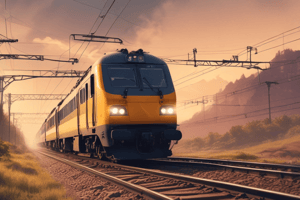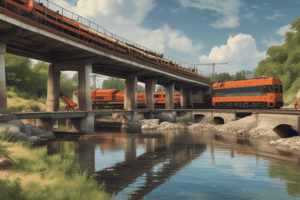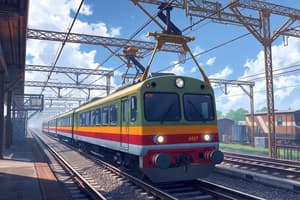Podcast
Questions and Answers
What was the primary reason for updating the Indian Railways Permanent Way Manual?
What was the primary reason for updating the Indian Railways Permanent Way Manual?
- To reduce the volume of the manual by 50%
- To integrate two manuals into one
- To include more obsolete materials
- To eliminate outdated practices and incorporate technological advancements (correct)
Which components were removed from the updated manual?
Which components were removed from the updated manual?
- Descriptions of modern materials
- Meter Gauge and Narrow Gauge specifications (correct)
- All rail types including 90R Rails (correct)
- Safety protocols for track inspection
How much was the volume of the Indian Railways Permanent Way Manual reduced after the update?
How much was the volume of the Indian Railways Permanent Way Manual reduced after the update?
- Approximately 30%
- Approximately 20% (correct)
- Approximately 40%
- Approximately 10%
Which group was involved in the scrutiny of the redrafted manual?
Which group was involved in the scrutiny of the redrafted manual?
In what year was the original Indian Railways Permanent Way Manual published?
In what year was the original Indian Railways Permanent Way Manual published?
What significant change was made regarding the chapters in the new manual?
What significant change was made regarding the chapters in the new manual?
Who is the author of the foreword for the redrafted Indian Railways Permanent Way Manual?
Who is the author of the foreword for the redrafted Indian Railways Permanent Way Manual?
What feature was added to the beginning of the manual for user convenience?
What feature was added to the beginning of the manual for user convenience?
What is one of the responsibilities involved in the repair of damaged track?
What is one of the responsibilities involved in the repair of damaged track?
What should be done to ensure safety before the onset of the monsoon?
What should be done to ensure safety before the onset of the monsoon?
Which document is required to accompany applications for works affecting passenger running lines?
Which document is required to accompany applications for works affecting passenger running lines?
What is meant by 'abnormal occurrences attributable to locomotives'?
What is meant by 'abnormal occurrences attributable to locomotives'?
Which type of training course is focused on enhancing previously acquired skills?
Which type of training course is focused on enhancing previously acquired skills?
What is a key feature of the Track Management System (TMS)?
What is a key feature of the Track Management System (TMS)?
What must be done when opening new lines after construction?
What must be done when opening new lines after construction?
Why is vigilance over railway affecting tanks important during heavy rains?
Why is vigilance over railway affecting tanks important during heavy rains?
What is a primary cause of rail deterioration?
What is a primary cause of rail deterioration?
What action should be taken upon detection of rail fractures?
What action should be taken upon detection of rail fractures?
What is essential for the maintenance of concrete sleeper fastenings?
What is essential for the maintenance of concrete sleeper fastenings?
What is involved in the deep screening of ballast?
What is involved in the deep screening of ballast?
What maintenance task addresses the corrosion of steel in concrete sleepers?
What maintenance task addresses the corrosion of steel in concrete sleepers?
Which document contains a record of gang work?
Which document contains a record of gang work?
What is a key purpose of maintaining signaling fixtures in track circuited areas?
What is a key purpose of maintaining signaling fixtures in track circuited areas?
What should be considered when laying PSC plain track sleepers?
What should be considered when laying PSC plain track sleepers?
What is the inspection frequency for tracks on routes with speeds above 110 Kmph?
What is the inspection frequency for tracks on routes with speeds above 110 Kmph?
Which of the following items is NOT mentioned as part of the track inspection checklist?
Which of the following items is NOT mentioned as part of the track inspection checklist?
How often should an entire section be inspected on multiple line routes?
How often should an entire section be inspected on multiple line routes?
What is the minimum requirement for gang work to be recorded during an inspection?
What is the minimum requirement for gang work to be recorded during an inspection?
For double or multiple lines running closely parallel, what should be done during inspections?
For double or multiple lines running closely parallel, what should be done during inspections?
What should be done if adequate blocks are not available for push trolley inspection?
What should be done if adequate blocks are not available for push trolley inspection?
Which of the following is a responsibility of an Assistant Divisional Engineer during inspections?
Which of the following is a responsibility of an Assistant Divisional Engineer during inspections?
What is the procedure for tracks with speeds below 110 Kmph but in busy multiple line routes?
What is the procedure for tracks with speeds below 110 Kmph but in busy multiple line routes?
How often should tunnels be inspected before the monsoon?
How often should tunnels be inspected before the monsoon?
What is the inspection frequency for side drains before the onset of monsoon?
What is the inspection frequency for side drains before the onset of monsoon?
Which of the following inspections occurs fortnightly?
Which of the following inspections occurs fortnightly?
How often should the entire section, including loop lines and yards, be inspected by foot according to the schedule?
How often should the entire section, including loop lines and yards, be inspected by foot according to the schedule?
Land verification inspections are scheduled how frequently?
Land verification inspections are scheduled how frequently?
What type of inspection is scheduled to occur once every year for the entire section including loop lines and yards?
What type of inspection is scheduled to occur once every year for the entire section including loop lines and yards?
What is the inspection frequency for small track machines?
What is the inspection frequency for small track machines?
What type of inspections occur in conjunction with state authority before the monsoon?
What type of inspections occur in conjunction with state authority before the monsoon?
Which inspection frequency applies to the JE/SSE/P.Way (Sectional) for the entire section including loops and yards?
Which inspection frequency applies to the JE/SSE/P.Way (Sectional) for the entire section including loops and yards?
What is the minimum frequency for checking that every gang member is aware of safety rules?
What is the minimum frequency for checking that every gang member is aware of safety rules?
What is the recommended frequency for inspecting other organizations' work?
What is the recommended frequency for inspecting other organizations' work?
Which track machines require inspection once during deployment?
Which track machines require inspection once during deployment?
What should be done if double/multiple lines are running closely parallel during an inspection?
What should be done if double/multiple lines are running closely parallel during an inspection?
Flashcards
Indian Railways Permanent Way Manual (IRPWM)
Indian Railways Permanent Way Manual (IRPWM)
A comprehensive document defining the construction, maintenance, and operation of railway tracks in India.
Track Standards Committee (TSC)
Track Standards Committee (TSC)
A committee responsible for setting standards and reviewing updates related to track infrastructure.
Research Designs and Standards Organisation (RDSO)
Research Designs and Standards Organisation (RDSO)
The body responsible for research, standards, and design in Indian Railways.
Redrafted IRPWM (2020)
Redrafted IRPWM (2020)
Signup and view all the flashcards
Advance Correction Slips (ACS)
Advance Correction Slips (ACS)
Signup and view all the flashcards
Reorganisation of the IRPWM
Reorganisation of the IRPWM
Signup and view all the flashcards
Indian Railways Institute of Civil Engineering (IRICEN)
Indian Railways Institute of Civil Engineering (IRICEN)
Signup and view all the flashcards
Ministry of Railways (Railway Board)
Ministry of Railways (Railway Board)
Signup and view all the flashcards
Inspection of Rails In Service
Inspection of Rails In Service
Signup and view all the flashcards
Casual Renewal of Rails
Casual Renewal of Rails
Signup and view all the flashcards
Rail Failures
Rail Failures
Signup and view all the flashcards
Lubrication of Rail Joints
Lubrication of Rail Joints
Signup and view all the flashcards
Deep Screening of Ballast
Deep Screening of Ballast
Signup and view all the flashcards
Lifting and Lowering of Track
Lifting and Lowering of Track
Signup and view all the flashcards
Side and Catch Water Drains
Side and Catch Water Drains
Signup and view all the flashcards
Record Keeping
Record Keeping
Signup and view all the flashcards
Restoration of Through Running
Restoration of Through Running
Signup and view all the flashcards
Diversion
Diversion
Signup and view all the flashcards
Transhipment
Transhipment
Signup and view all the flashcards
Funds Required During Emergencies
Funds Required During Emergencies
Signup and view all the flashcards
Track Management System (TMS)
Track Management System (TMS)
Signup and view all the flashcards
Training Courses for Railway Personnel
Training Courses for Railway Personnel
Signup and view all the flashcards
Certificate of Competency
Certificate of Competency
Signup and view all the flashcards
Category of Medical Examination
Category of Medical Examination
Signup and view all the flashcards
Foot Inspection
Foot Inspection
Signup and view all the flashcards
Push Trolley Inspection
Push Trolley Inspection
Signup and view all the flashcards
Safety Rule Awareness
Safety Rule Awareness
Signup and view all the flashcards
Reviewing Subordinate Inspections
Reviewing Subordinate Inspections
Signup and view all the flashcards
Combined Inspection for Parallel Lines
Combined Inspection for Parallel Lines
Signup and view all the flashcards
Assistant Divisional Engineer (ADE) Inspection Schedule
Assistant Divisional Engineer (ADE) Inspection Schedule
Signup and view all the flashcards
Foot Inspection/Push Trolley Inspection
Foot Inspection/Push Trolley Inspection
Signup and view all the flashcards
Items Checked During Foot Inspection/Push Trolley Inspection
Items Checked During Foot Inspection/Push Trolley Inspection
Signup and view all the flashcards
Inspection Frequency
Inspection Frequency
Signup and view all the flashcards
SSE/P.Way (In-charge)
SSE/P.Way (In-charge)
Signup and view all the flashcards
SSE/P.Way Gang Inspection
SSE/P.Way Gang Inspection
Signup and view all the flashcards
Push Trolley Inspection Scope
Push Trolley Inspection Scope
Signup and view all the flashcards
Block Protection During Inspection
Block Protection During Inspection
Signup and view all the flashcards
Tunnel Inspection
Tunnel Inspection
Signup and view all the flashcards
RAW/RAT Inspection
RAW/RAT Inspection
Signup and view all the flashcards
Cutting Inspection
Cutting Inspection
Signup and view all the flashcards
Private Siding Inspection
Private Siding Inspection
Signup and view all the flashcards
Land Verification Inspection
Land Verification Inspection
Signup and view all the flashcards
Drainage Inspection
Drainage Inspection
Signup and view all the flashcards
Small Track Machine Inspection
Small Track Machine Inspection
Signup and view all the flashcards
Track Machine Inspection
Track Machine Inspection
Signup and view all the flashcards
Study Notes
Indian Railways Permanent Way Manual (IRPWM)
- Published in 1986, updated to ACS-1 in 2024
- Updated manual incorporates technological advancements, removing obsolete materials like 90R Rails, Wooden, and Steel Sleepers.
- Meter Gauge and Narrow Gauge sections are omitted, with the old IRPWM provisions remaining applicable.
- Combined IRPWM and LWR (likely Light Welded Rails) manuals into one
- Reduced volume by approximately 20%
- Reorganized content by grouping similar topics into chapters for clarity.
- Includes abbreviations and terminology for quick reference.
- Approved by several committees and the Railway Board after review.
Part B: Handling & Maintenance of Rails, Sleepers, Fastenings
- Covers handling and stacking of rails
- Includes inspection of rails in service
- Outlines causes of rail deterioration and maintenance strategies
- Details rail closures, attention to defective rails/welds, and casual rail renewals
- Includes rail failures, actions for fractures/weld failures, lubrication of rail joints, and fish-plate maintenance
- Provides information on insulated/glued rail joints and sleeper laying procedures (PSC plain sleepers, fan-shaped turnout sleepers, concrete sleeper renewals)
- Explores concrete sleeper corrosion and fastening maintenance
- Addresses steel sleeper use for bridges, bridge approach and bridge proper track maintenance, yard line maintenance, sand hump and dead-end details, standard track sections, and gang work checking.
Part C: Incidental Track Maintenance Works
- Includes deep ballast screening procedures
- Covers track lifting and lowering
- Details side and catch water drains, drainage in station yards, section limit boards, kilometre and gradient posts, OHE mast numbering, land boundary verification
- Discusses trolley refuges, standard dimensions, tree felling, distance pieces for platform lines, fouling marks, P.Way store maintenance, and derailment actions
Part D: Record Keeping
- Describes gang work record-keeping
- Outlines records for artisans and other workmen
- Provides procedures for half-yearly permanent way condition reports, SSE/P.Way section registers, permanent way plans and diagrams, musters, gang strength and jurisdiction, and gang tool custody
- Includes record-keeping on materials under trial
Part E: Track Maintenance in Track Circuited Areas
- Covers provisions and maintenance of signaling fixtures within track circuited areas
Restoration of Through Running
- Details repairs to damaged track, labor procurement, diversions, transhipment, emergency funds, track obstructions, flooded causeways, submerged track precautions, driver reports on track defects, abnormal occurrences, accidents, accident inquiries, records of accidents, and accident statements.
Pre-Monsoon Precautions
- Outlines general precautions before monsoon
- Covers emergency materials, service spans, railway affecting works, vigilance over railway tanks during heavy rain, and weather warnings and actions.
CRS Sanction for Works Affecting Passenger Running Lines
- Covers references to relevant acts and rules
- Details works requiring Commissioner of Railway Safety (CRS) sanction, application procedures, accompanying documents, safety certificates, plan deviations, applications for new locomotives/rolling stock, notifications to officials, and works arising from accidents.
Track Management System (TMS)
- Discusses general aspects of TMS
- Explains modular structure of TMS and its integration with TRC and OMS.
- Describes security and information management features of TMS
- Outlines TMS utilization and register withdrawal procedures
- Defines administrators within TMS
Training, Competency, and References
- Covers training course types, induction courses, promotional courses, refresher courses, and special courses
- Details competency certificates, welder training and certification, medical examination categories, and reference books
- Includes instructions on relinquishment/transfer of charges for ADEN officers
Inspection Schedule for Assistant Divisional Engineer (Table 1A)
- Provides schedules for various inspections (foot inspections, push trolley inspections, tunnels, RAW/RAT, cuttings, private sidings, land verification, side drains, catchwater drains, bridge waterways, SSE/P.Way office/store, small track machines, track machines, and other organizations)
- Includes frequency, specific items checked, and special considerations (e.g., speed limits, multiple lines, tunnel inspections, monsoon-related checks)
Studying That Suits You
Use AI to generate personalized quizzes and flashcards to suit your learning preferences.
Related Documents
Description
Test your knowledge on the Indian Railways Permanent Way Manual (IRPWM) and its updates. This quiz covers topics such as the handling and maintenance of rails, sleepings, and fastenings, as well as technological advancements in the field. Challenge yourself with questions about the integration of older and newer rail standards and the maintenance strategies outlined in the manual.




